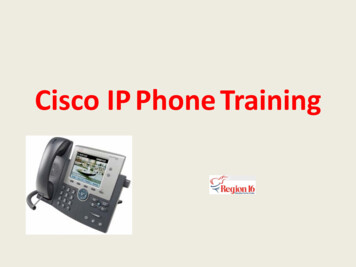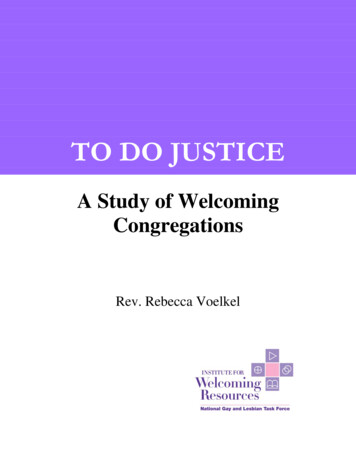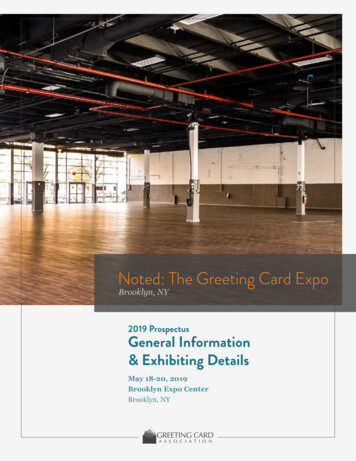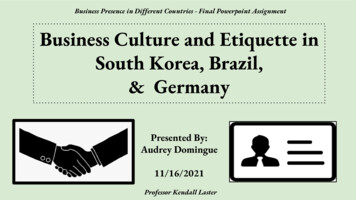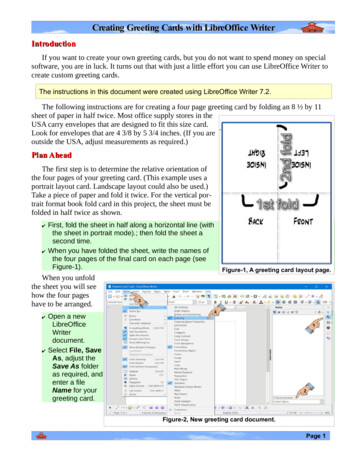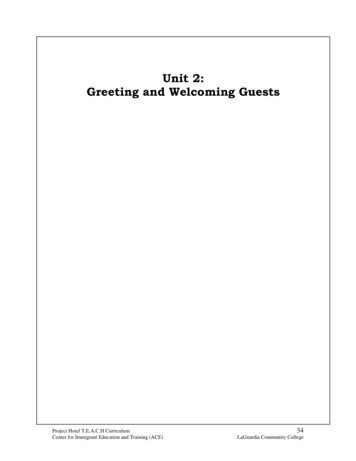
Transcription
Unit 2:Greeting and Welcoming GuestsProject Hotel T.E.A.C.H CurriculumCenter for Immigrant Education and Training (ACE)34LaGuardia Community College
Hotel TEACH Lesson PlanUnit 2, Lesson 1Career Counseling: Confidence Building and Self-PresentationObjective:Sts will assess themselves to identify where they lack confidence, andpractice various forms of self-presentation to present themselvesconfidently on the job.EFF StandardsIndustry StandardsReflect and Evaluate: Make inferences,predictions or judgments based on one’sreflections.Act with Professionalism & IntegrityCommunicate with OthersActivity 1: Definition of ConfidenceT writes the following questions on the board and asks Sts to take 5minutes and think about how they would respond. Sts can write notes ifthey need to.Where do you want to be in 5 years? What are your professional and personalgoals?After Sts have taken the time to think of their answers, T breaks Sts intogroups of 4 or 5 and asks them to get up in front of the class as a groupand introduce themselves to each other and explain their goals andwhere they would like to be in 5 years.After Sts in the groups introduce themselves, T asks the Sts:Who felt they could have used more confidence while making their introductions?Did anyone feel shy or uncomfortable? Would it have made a difference in theirconfidence if they had answered the question in their native language?Repeat with the next group of Sts.T asks Sts to describe confidence. T can use the following prompts toelicit responses:Confidence is believing in yourself and your ability to do a job well.Confidence is accepting yourself as you are and loving yourself unconditionally.Confidence is releasing fear of failure and trusting your ability to succeed.Confidence is not being arrogant or conceited; confidence is being self-assured.Confidence is being relaxed.Confidence is a learned behavior.Project Hotel T.E.A.C.H CurriculumCenter for Immigrant Education and Training (ACE)35LaGuardia Community College
T asks Sts to write the definition in their notebooks and/or journal.T then introduces the following stress-buster exercise. This exercisehelps to reduce anxiety and feelings of nervousness and promoterelaxation.1. Sit or stand in a relaxed position.2. Slowly inhale through your nose, silently counting to 5.3. Let the air out from your mouth, silently counting to 8 as it leavesyour lungs. Repeat several times.Activity 2: Assessing Self-ConfidenceT asks Sts to call out areas in their life where they feel confident, andlists them on the board in a column (e.g., as a parent, as a student, as acook, their ability to be creative or communicate with others).Why do you feel confident as a ? Why do you feel confidentwhen you ?T writes St responses on the board in a separate column. (Sampleanswers: I have experience in this role, practice, I have support, I get apositive response, I feel good doing this, I have studied this skill, etc.)T explains that true confidence comes with time, experience, selfacceptance and positive self-esteem. If Sts can say why it is they feelunconfident, they can seek solutions to change the situation.T then asks Sts the following question and lists the responses on theboard:What are some of the reasons why people feel unconfident?(Examples: They are new to a job and may not feel confident in their performance,low self-esteem, lack of support)T then asks Sts:Can you learn how to be confident? How?What can you do to change negative feelings and build confidence?(Examples: Be patient with yourself, look for support, talk to someone aboutinsecurities, practice positive thinking, learn more about your new position, bemotivated, be flexible, take inventory of all the positive things in your life, identifyand use your strengths)Remind Sts that they can cultivate confidence, even if they don’t alwaysfeel that way, by practicing relaxation techniques and positive thinking.Activity 3: Confidence and Self-PresentationT asks Sts:Project Hotel T.E.A.C.H CurriculumCenter for Immigrant Education and Training (ACE)36LaGuardia Community College
Why would employers look to hire people with confidence? Would they hiresomeone who is unconfident? Why or why not?(Example: Having confidence causes customers and co-workers to feel that youare reliable and competent. (A worker who displays unconfident behaviors maybe viewed as less effective and unreliable.)T then distributes the following answer cards to Sts: OK in the United States.Not OK in the United States.OK in my country.Not OK in my country.T then reads aloud the following questions about confidence andinstructs Sts to raise the cards that best reflect their opinion. Each Stshould hold up an answer that reflects whether it is OK or not OK inboth his/her home country and the United States. Ask Sts to explainwhy they are holding up the answers they chose and give examples.While each statement is being made, T can act out what is being read.Is it OK or not OK to: Look at customers directly in their eyes when theyspeak to you. Look at the floor when your manager talks to you. Cover your mouth and look down when you arespeaking. Touch people on the shoulder when you explainsomething to them. Speak quietly when addressing a guest. Engage in small talk with customers and supervisors. Shake hands when you are introduced to a supervisor. Cross your arms when you are talking with guests. Make jokes with your co-workers and supervisors. Ask your supervisor questions.After this exercise, T asks Sts to describe what confidence looks like inthe United States. T writes down the answers on the board under theheading Confidence. T can elicit responses with the following questions: What is the body language?How is eye contact important?How do you stand when confident? How is your head held? How do you feel?What do you do with your arms? Are they crossed? Are your hands in yourpockets? At your sides? What message does this convey?How does confidence/nervousness affect your breathing?How is your physical distance from the person you are speaking with? Is it tooclose or too far?What kind of thoughts would a confident person be thinking?Project Hotel T.E.A.C.H CurriculumCenter for Immigrant Education and Training (ACE)37LaGuardia Community College
Conversely, ask Sts, How does someone who is unconfident appear? Usethe same prompts.Activity 3: Confidence Role PlayHave Sts go around the room and introduce themselves and talk abouttheir goals to each other using unconfident body language andexpressions. After each has had his/her turn, Sts role-play usingconfident body language and expressions. T reminds the Sts thatconfidence is a state of mind, and they can practice communicatingconfidently by being aware of their body language and thinking positivelyabout themselves.After activity, T asks the class:What did you do to show the difference between unconfident and confidentbehavior? Was there any difference in how you felt?Journal ExerciseInstruct Sts to observe people on the job who appear confident. If Sts arenot working, they can observe people on the subway or bus. What dothey do to communicate confidence? Have Sts write their observations intheir journal. Instruct Sts to take this a step further and be aware oftheir own body language when they speak to their co-workers, managersand guests of the hotel. Practice confident body language andexpressions with each group of people. Write in your journal what waschallenging about the exercise and what was good about the exercise.Journal Exercise 2Positive self-talk empowers you, makes you stronger and buildsconfidence. Think about the negative things you say to yourself thatmake you feel unconfident. Write these statements in your journal, andthen write a positive message to replace them. For example, “It takes mea long time to learn new things” can be replaced with “I learn new thingseasily and effortlessly.” Repeat these positive statements silently toyourself when you are on the train or bus. Next time you catch yourselffeeling unconfident, (1) recognize the thought; (2) STOP it immediately;and (3) think your positive message.ExtensionInstruct Sts to visit the following link and review the Self-Esteem GuidedTour. After they take the tour, have Sts enter their e-mail to receive tipsfor building positive ey.shtmlProject Hotel T.E.A.C.H CurriculumCenter for Immigrant Education and Training (ACE)38LaGuardia Community College
Teacher TipsWhile teaching this lesson, be mindful that Sts may come from culturesthat view eye contact and confident body language as disrespectful. Donot downplay these traditions, but introduce how American culture isdifferent and how employers value workers who are self-confident andassertive. What they think is respectful and polite behavior may beholding them back from success.Remind Sts to release the need to be self-critical and avoid comparingthemselves with others.Project Hotel T.E.A.C.H CurriculumCenter for Immigrant Education and Training (ACE)39LaGuardia Community College
Hotel TEACH Lesson PlanUnit 2, Lesson 2Service Basics: Elements of Customer ServiceObjectiveIntroduce the “how-to’s” of four service areas and how they build on eachother to provide “quality service” at the hotel.EFF StandardsIndustry StandardsReflect and Evaluate: Take stock of where one is:what one knows already and the relevance of thatknowledgeLearn, Develop, Adapt to ChangeActivity 1 – VideoT tells Sts that they will be watching a video to give the class an overviewof the course and that the video will be an introduction to four serviceareas:1.2.3.4.How to exceed expectationsHelping guests and co-workersHandling guest complaintsImproving service(T writes the four areas on the board.) T asks Sts the following question:Have you ever stayed at a hotel in this country?Have you ever stayed at a hotel that provided great customer service.orHave you ever had great customer service in a deli or department store in NewYork?After a St tells the story, T asks the class:What area would this story go under — exceeding expectations, giving qualityservice, handling guest complaints or improving service? Or did it fall undermore than one?T passes out Handout 1 to the Sts and class watches part 1, theExceeding Expectations Section of the AHLA “Delivering Quality Service”video. T replays section to confirm answers for a, b, c, d, e, f of thehandout.T then plays the next three segments, stopping after each one, askingcomprehension and vocabulary questions. Sts complete the worksheets.Activity 2: Making a TableT has Sts take their worksheets to the computer lab so they can makeMS Word tables.Project Hotel T.E.A.C.H CurriculumCenter for Immigrant Education and Training (ACE)40LaGuardia Community College
T shows Sts an example of a table or draws it on the board and identifiesthe rows and columns, like this:Row (Across)ColumnT asks Sts:How many service areas are there? Four service areasWhere should we put them? Across the top in the first row. List examples in thecolumns below.Sts make their tables according to the instructions, Making Tables, page37 in their Computer Handbook. They may personalize them bychoosing their own fonts and clip art pictures. The table will look likethis:Extension ActivitySts can review the video by looking at their table and quizzing each otherwith questions like:WhatWhatWhatWhatpart of the story focused on reading the person?guests needed help?did they mean about professional appearance? Describe it.was the example of “courtesy?”Project Hotel T.E.A.C.H CurriculumCenter for Immigrant Education and Training (ACE)41LaGuardia Community College
Materials: AHLA Video, #05121VHS02ENGE, “Delivering QualityService”Teacher TipsThis lesson lays the groundwork for Customer Service in the HotelIndustry. The video is 17 minutes long and includes a story to illustratethe four steps. I would suggest getting this video because itencompasses all four topics succinctly; often these topics are dealt withseparately.Making a table is both a computer lesson and a discussion starter for thestudents. Doing a document like this early in the course is enjoyable forstudents who have few or no computer skills. They especially like usingclip art to make it look professional. The activity should be done inpairs, in the event that some students will have few typing skills.Project Hotel T.E.A.C.H CurriculumCenter for Immigrant Education and Training (ACE)42LaGuardia Community College
DeliveringQualityService1Unit2, Lesson2: HandoutDirections: As you watch the video, fill in the answers you hear.1) What are 6 ways to meet or exceed expectations?a.b.c.d.e.f.2) How can you give quality service to guests and co-workers when they ask forhelp?a.b.c.d.e.3) What are the steps to handling a guest complaint?a.b.c.d.4) How can everyone improve quality service?a.bb.Project Hotel T.E.A.C.H CurriculumCenter for Immigrant Education and Training (ACE)43LaGuardia Community College
Answers for Handout 1Delivering Quality Service1. What are 6 ways to meet or exceed expectations?a) professional appearanceb) friendlinessc) courtesyd) empathye) responsivenessf) flexibility2. How can you give quality service to guests and co-workers whensomeone asks you for help?a) Read personb) Determine what person needsc) Work together to find solutionsd) Deliver the servicee) Follow up3. What are the steps to handling a guest complaint?a) Listenb) Respond by apologizingc) Take action to solve problemd) Follow up by monitoring actions and checking thatguest is satisfied4. How can everyone improve quality service?a) Share guest feedback on service quality withmanagementb) Look for opportunities to improve serviceProject Hotel T.E.A.C.H CurriculumCenter for Immigrant Education and Training (ACE)44LaGuardia Community College
Hotel TEACH Lesson PlanUnit 2, Lesson 3Greeting Guests and Co-workersObjective:Sts focus on the guests and co-workers and what appropriatecommunication is, including body language and tone.EFF Skill SetsIndustry Skills SetsObserve Critically: Attend to visual sources ofinformation, including television and othermedia.Follow Policies and ProceduresActivity 1: GreetingsT gives each St a sticky note with one of the following profiles or pictureson it:guestsupervisor, co-worker, co-worker from another department, head of department,Sts walk around room, greeting their classmates. Sts greet eachclassmate by name. At the end, the T elicits the expressions they used.How did you greet your classmates and colleagues? How did you greet eachother nonverbally?Activity 2: Body language in greetingsT plays the “Workplace Essential Skills” (WES) video, program 12, withno volume, starting at 18:20. Sts watch the hotel workers and noticetheir body language. Sts look for positive and negative body language. Twrites “Positive” and “Negative” on the board, and Sts provide examples:Positiveeye contactsmilinglistening closelyworkinganimated or using gestures when speakingNegativechewing on a penciltapping hand with a pencilleaning up against the wallstanding around just waitingIf necessary, replay the WES video without volume to see if there wereother body language signals that Sts missed. T asks Sts to predict howthe voices of the bellhop and supervisor will sound. T asks Sts toProject Hotel T.E.A.C.H CurriculumCenter for Immigrant Education and Training (ACE)45LaGuardia Community College
describe how they think their voices may sound — for example, deep,confident, strong, enthusiastic.T encourages Sts to come up with as many adjectives as possible orinclude opposites. T plays the video one last time, with volume. Stslisten to describe the bellhop’s and supervisor’s voices. T asks Sts:Do their voices sound like you thought they would?Now, if you CAN’T see the guest (e.g. on the telephone):What can you do to make the guest feel your positive body language and facialexpressions? Can you hear the guest’s body language?T fast-forwards video to 21:08, and class watches video for approximatelytwo minutes, this time with sound.Sts listen for the answer to:How should you keep your voice?Clear, direct and upbeatDiscuss: How do these employees view their work? What is their work philosophy?What surprised you about what they said?Activity 3: Service BasicsT distributes the 11 Service Basics to Sts, and they read page together. Texplains that these are 11 rules or guidelines that have been created forhotel workers to use when interacting with guests. Ask Sts:Why do you think there are rules or guidelines?(Answer- so that guest experiences are consistent with every employee the guestinteracts with, so that all guests have an equally positive experience during theirstay, etc.)T briefly reviews rules with the Sts. Have Sts pay special attention tonumbers 1 and 10. T asks Sts to circle these numbers on their paper. Treviews the rules with Sts by asking them to act out what these rules“look like.” At this point, the teacher can review any language that hascome up, such as using Ma’am, Sir, Mr., Mrs., Ms., etc.Activity 4: Role-play and reviewFirst, T gives out Handout 1 and then writes the following samplescenario on the board:Greet two guests as they approach the front desk. (Guests arean elderly couple. One is blind.)T asks for two volunteers to play the guests and gives them a pictureof themselves (from magazines) to tape to their shirts, so classmatescan see who they are.T plays the Desk Clerk and greets the guests by saying:Front Desk Clerk: Good afternoon. Welcome to City View Hotel. How may Iassist you?Guests: Hello, we would like to check in. The name is Wallenstein.Front Desk Clerk: Absolutely. Let me pull that up for you. It will only take afew seconds. Here it is, Wallenstein, Alfred. For January 3rd to the 8th, is thatcorrect?Project Hotel T.E.A.C.H CurriculumCenter for Immigrant Education and Training (ACE)46LaGuardia Community College
Guests: Yes, it is.T asks Sts:Did I use Rule 1? Yes, you greeted them using the 10-5 ruleHow about Rule number 10? Yes, you said Hello, not Hi, and said, “How may Iassist you?” instead of “What do you want?” or something like that. You didn’tstare at the blind person.T encourages Sts to give specific examples for their answers.Next, Sts get into groups of three and each group chooses onescenario from Handout 2 from the hat. Each St will take a role aseither a guest or an employee. Model the activity by having one groupact out a scenario in front of the class. Follow up by having the Stscomment on which rules the worker used with the guests and whatbody language also demonstrated the rules. Sts should have usedrules number 1 and 10.Next, T has another group repeat the scenario but without using therules (no eye contact, mumbling, etc.). Follow up by having Stscomment on what the worker did that was inappropriate and comparethe two role plays.Finally Sts will act out various role plays in their groups of threeusing the service rules and appropriate body language.T reminds Sts they should play the guest roles as cranky, enthusiastic,formal, etc.Extension ActivityHave students count how many shops they go to over the week whereworkers greet them as they walk in or around the store. Try one day todress up and shop, and then the next day dress casual. Have them keepa list of the ways they’re greeted.MaterialsPictures of guests (see Teacher Tips)Workplace Essential Skills Video, Program 12 –1st Clip set at 18:20 and play one minute, approx 19:202nd clip set at 21:08 (play until 23:45 or when next segment starts in thecafé)Teacher TipsFor non-incumbent students, use the alternative question in Activity 1,as they may or may not have stayed in a hotel. Give them time to thinkof a good experience, or work backward from a bad experience if that isProject Hotel T.E.A.C.H CurriculumCenter for Immigrant Education and Training (ACE)47LaGuardia Community College
all they can think of. Also, keep the role plays realistic and note thatsuch communication exchanges are usually brief. Afterward, you mayask them if the role play was too long or too short. While watching thevideo clips, repeat them with sound if necessary, as some of theemployees speak fast.In order to further practice descriptive adjectives, I enjoy using a “puzzlemaker” to generate review word search, which you can find at:http://puzzlemaker.school.discovery.com/I used Google/Images to come up with a picture collection of typicalguests at your hotel. Cut out the photos and mount them on indexcards, or laminate them for repeated use during the course.Project Hotel T.E.A.C.H CurriculumCenter for Immigrant Education and Training (ACE)48LaGuardia Community College
Unit 2, Lesson 3: Handout 1Sheraton’s 11 Service Basics1)10-5 RuleWhen you are within 10 feet of our guests, initiate eye contact with a genuine smile. When you arewithin 5 feet, acknowledge our guests with a warm and sincere greeting.2)Escort Our GuestsAnticipate our guests’ needs by escorting them to their destination. If you are unable to do so,always ask a fellow associate for assistance. Do not point.3)Extend CourtesyExercise common courtesies with our guests; always allow guests to enter or exit any area first(elevators, doorways, etc.).4)One Hundred PercentKnow your internal and external customers’ (employees and guests) expectations. When a guestexpresses concern, say “I apologize” or “I’m sorry.” Take ownership and follow up to ensure guests’satisfaction.5)Our Guests Have NamesRemember to use guests’ names whenever possible. Doing so makes them feel welcome and right athome.6)Telephone CourtesyA ringing phone is the first impression we make with our guests. Always use proper telephoneetiquette: answer the telephone within three rings, with a smile in your voice. Use a pleasantgreeting; state your name and department, and say, “How may I assist you?” When necessary, askthe guest if he/she can hold. Do not place them on hold without their agreement.7)Exceed ExpectationsProvide our guests with their unexpressed wishes and desires. Strive to enhance each guest’sexperience of the hotel by going beyond his/her usual requests.8)Never Say NoEvery guest request can be fulfilled. If you are unable to meet our guests’ expectations, be creativeandalways offer options. When you don’t know the answer to a question, find someone who does.9)Look ProfessionalThe image you project forms our guests’ first impressions of the hotel. Take pride in your personalappearance by maintaining an immaculate uniform (i.e., clean, unwrinkled clothes, polished shoes,neatly groomed hair and nails, etc.). The most important part of your uniform is your smile.10) Speak ProfessionallyAlways use proper vocabulary and grammar when speaking with our guests. (Use words like “yes”instead of “OK” or “yeah,” “hello” instead of “hi,” “thank you” instead of “thanks” or “uh-huh,” and“us,” “we,” “ours” instead of “they, “them.” “theirs.”)11) Have fun!Create a pleasurable environment so that everyone leaves the hotel with a positive memory and looksforward to returning.Attitude is contagious.Project Hotel T.E.A.C.H CurriculumCenter for Immigrant Education and Training (ACE)49LaGuardia Community College
Unit 2, Lesson 3: Handout 2SCENARIOS:“Greet the Guests!”Directions: Cut out scenarios, and have Sts choose one scenario for their group. SupplySts with photos of the guests, so they can visualize the guest better.Sample Scenario:Greet two guests as they approach the front desk. (Guests are an elderly couple.One is blind.)#1 Greet two guests as they enter the hotel. (Guests are very tired.)#2 Greet two guests as they enter the hotel. (Guests are famous people.)#3 Greet two guests as they enter the restaurant, and check their reservation.(Guests have a last name that is difficult to pronounce.)#4 Greet a guest who’s walking down the corridor while you are doing yourhousekeeping.#5 Greet a guest who calls from Room 2365 to order from room service.#6 Greet guests who are coming into the pool area. (Guests are a family withtwo young children.)#7 Greet two guests who are arriving at the hotel. (One guest is in awheelchair; the other is pushing it and has a shopping bag hanging from herarm.)Project Hotel T.E.A.C.H CurriculumCenter for Immigrant Education and Training (ACE)50LaGuardia Community College
Hotel TEACH Lesson PlanUnit 2, Lesson 4A“Small Talk”Chatting While Waiting for an Elevator or AppointmentObjective: Students gain confidence initiating appropriate “small talk”conversations at the workplace.EFF Skill SetsSpeak so Others Can Understand: Organizeand relay information to effectively serve thepurpose, context and listenerExceed Customer ExpectationsIndustry Skill SetsIntroductionT begins class with a comment on something in the day’s newspaper.Did you hear about (local news story)?Did you see the game last night?So do you think it’s going to be this cold all week?T observes how many Sts answer and how they comment on theprompts.Notes are taken of any language or pronunciation issues for laterfeedback.Activity 1: Small Group Discussion and FeedbackT puts Sts in small groups and dictates the following questions:1. Why did I start class by asking about the [weather/sports]?2. Was this a serious question or just “small talk”?3. Where and when do you have “small talk” conversations?4. List three “small talk” conversation topics here in the U.S.?5. Are the topics different in your country?Sts discuss the questions in small groups and then nominate aspokesperson to share the group’s ideas with the whole class. T elicitsfeedback on the prompts from the group spokespeople.T writes on the board appropriate “small talk” conversation topics elicitedfrom the Sts.T then asks if there are any topics you should NOT discuss in “smalltalk” and why. T writes the Sts’ ideas in a parallel column on the board,e.g.:OKweathersportstransportationNOT OKpolitics“personal” issuesphysical appearanceT asks Sts to brainstorm other possible “rules” about “small talk.”Does it change when men, rather than women, are talking?When should you NOT start a conversation with someone?Project Hotel T.E.A.C.H CurriculumCenter for Immigrant Education and Training (ACE)51LaGuardia Community College
Activity 2: Weather DialogueIn the same groups with a local newspaper, Sts are asked to:Think of a scenario where you might need to use weather “small talk” at the hotel.Look for the weather report for the rest of the week.Use this information to write a 5-line dialogue, e.g.:John: “Isn’t it cold out today?”Mary: “Oh yes, and it’s supposed to snow tomorrow!”T asks one or two groups to perform their dialogues.Pronunciation and grammar correction is done as necessary.T asks Sts to listen for:1) Opening line2) Appropriate length3) Appropriate registerActivity 3: Newspaper Role PlayAgain using the newspapers, Sts are asked to create different “small talk”dialogues on topics taking place in different locations in a hotel, byelevator, by the water cooler, in the cafeteria, etc. Topics (see Handout1) — both appropriate and possibly inappropriate — with locations, aregiven out to groups (stronger groups can be given blanks and choose anytopic from the newspaper).T passes out roles on index cards that say co-worker, supervisor orguest, and Sts tape one to their shirts. Sts can use the blackboard todraw a picture of the elevators, cafeteria, etc., to “set the stage.”Other Sts must watch the group performing and decide the following:Where are they? Who are they?What are they talking about?What expressions did they use?Was it an appropriate conversation?Extension ActivitySts write down descriptions of one successful or one unsuccessful “smalltalk” conversation they had at the hotel. Non-incumbent Sts can give anexample from their last job or trip to a store, where they tried to chatwith a stranger. Analyze why it was successful or not.Teacher TipsIf your Sts are non-incumbents, they will need to use “small talk” skillswhile on interviews. You may want to have Sts do role plays on chattingwith the secretary while waiting in an empty office for an interview orchatting with the interviewer before the interview actually begins. Theweather is an excellent topic for this situation, or have studentscomment on an object they see in the interviewer’s office. Again, theseconversations don’t last long or stray too far from the reason why theyare at the interview. That is to get the job. You may want to do a minilesson on giving and receiving compliments. Speaking Naturally, Unit 7Project Hotel T.E.A.C.H CurriculumCenter for Immigrant Education and Training (ACE)52LaGuardia Community College
“Giving Compliments and Replying to Compliments” will give students agood introduction on how to do this. In the interview, when they saysomething nice about an item in the office, the person will usually tell astory about it. It is a good way to break the ice without getting too far offtrack.Project Hotel T.E.A.C.H CurriculumCenter for Immigrant Education and Training (ACE)53LaGuardia Community College
Unit 2, Lesson 4A: Handout 1Directions: Make copies and cut out enough for your class. If you have a higher level, youmay have them design their own small talk role plays using the blank forms.An associate and a guest are talkingabout sports at the hotel bar.An associate and a supervisor aretalking about commuting problems whilewaiting for the elevator.Two associates are talking about apopular TV show while in line at thecafeteria.An associate and a guest are talking atthe front desk about the President of theUnited States.An associate and a supervisor aretalking about celebrity gossip whileleaving the hotel after their shift.Two associates are talking about theirjob in the locker room.An associate and a supervisor aretalking about while.An associate and a guest are talkingabout at the .An associate and a supervisor are
Center for Immigrant Education and Training (ACE) LaGuardia Community College Hotel TEACH Lesson Plan Unit 2, Lesson 2 Service Basics: Elements of Customer Service Objective Introduce the "how-to's" of four service areas and how they build on each other to provide "quality service" at the hotel.
